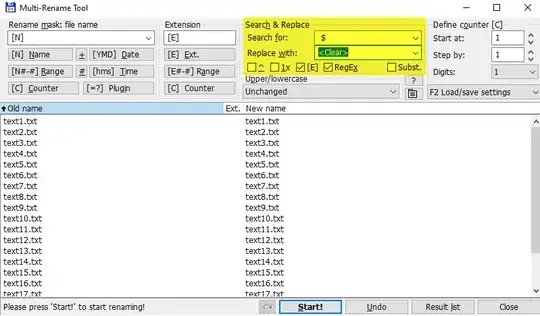PowerShell, cmd and most other Win32 applications have no issue interacting with the file as long as you know how to bypass the Windows name normalization with the \\?\ prefix:
PS D:\space> 1..20 |% { New-Item -Path "\\?\D:\space\test$_.txt " }
PS D:\space> Get-ChildItem |% { '"' + $_.Name + '"' }
"test1.txt "
"test10.txt "
"test11.txt "
"test12.txt "
"test13.txt "
...
"test8.txt "
"test9.txt "
PS D:\space> Get-ChildItem |% {
Rename-Item ("\?$PWD" + $.Name) ($.Name.SubString(0, $_.Name.Length - 1)) }
PS D:\space> Get-ChildItem |% { '"' + $_.Name + '"' }
"test1.txt"
"test10.txt"
"test11.txt"
"test12.txt"
"test13.txt"
...
"test8.txt"
"test9.txt"
In cmd you can also do the same
D:\space>for /l %i in (1, 1, 10) do @echo %i > "\\?\D:\space\%i.txt "
D:\space>forfiles
"1.txt "
"10.txt "
"2.txt "
"3.txt "
"4.txt "
"5.txt "
"6.txt "
"7.txt "
"8.txt "
"9.txt "
D:\space>for /l %i in (1, 1, 10) do @ren "\?\D:\space%i.txt " "%i.txt"
D:\space>forfiles
"1.txt"
"10.txt"
"2.txt"
"3.txt"
"4.txt"
"5.txt"
"6.txt"
"7.txt"
"8.txt"
"9.txt"
In short, NTFS is fully POSIX-compliant and can contain names with any characters except / and NUL. But the Win32 namespace is much more limited, and Win32 applications using normal Win32 APIs can't access files with names that are invalid in the Win32 namespace, which include names ending in spaces or periods
Do not end a file or directory name with a space or a period. Although the underlying file system may support such names, the Windows shell and user interface does not. However, it is acceptable to specify a period as the first character of a name. For example, ".temp".
Naming Conventions
The \\?\ prefix sends the name directly to the driver, which allows us to operate on files with invalid names, or files with very long paths. Many tools like 7z, winrar, robocopy, TotalCommander... know how to prepend \\?\ so they can deal with those files, but for normal tools you need to prepend it yourself
In fact PowerShell Core also use \\?\ automatically in various places, unlike PowerShell 5.1 and older which you have to do that yourself. But there are still some bugs here and there so sometimes you'll have to remove \\?\ and let PowerShell Core do that itself
There are lots of related and duplicate questions:
